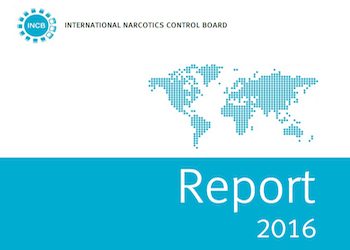The latest annual report from the International Narcotics Control Board (INCB) describes a continuing trend of growing drug use in the Americas, and encourages countries to seek “non-punitive” solutions for dealing with this issue.
The INCB report released March 2 notes that usage rates of many common drugs continue to climb in the region, in an extension of a pattern observed in earlier years.
In North America, the report notes that increased opioid consumption in the United States and Canada has led to a concomitant rise in overdoses related to this category of drugs. The report also provides data suggesting crime groups have increased production of opium poppies in both Mexico and Guatemala in recent years in order to meet the growing demand.
The report states that drug usage rates in countries of Central America and the Caribbean tend to be lower than global and regional averages. But the authors argue that due to these nations’ importance as drug transshipment countries, usage rates could rise or fall with shifts in production and trafficking patterns.
In South America, the INCB reports that the annual rates of the use of cannabis — the most widely-consumed drug in the region — “presented an overall upward trend.”
Similarly, the prevalence of cocaine abuse in South America also “continues to increase,” likely fueled in part by a boom in Colombian cocaine production that has also been linked to increased cocaine consumption in the United States.
The INCB also notes that other types of drugs appear to be growing in popularity.
“Concern over rising levels of abuse of synthetic drugs among young people in South America also continued to grow in 2015,” the report states. “High annual prevalence rates of abuse of amphetamine-type stimulants among young people were reported in the region.”
InSight Crime Analysis
These trends are not new. But the INCB’s report encourages countries to rethink traditional strategies for dealing with these evolving dynamics.
Specifically, the INCB advocates for the principle of “proportionality” outlined by international anti-narcotics agreements. According to the agency, “disproportionate” responses to drug crimes can “undermine the aims of the conventions and can also have a negative impact on the application of and compliance with the rule of law.”
Although the INCB report does not specifically name any countries, some of the issues it points to have come up in Latin America and the Caribbean.
For example, the report urges countries “to adopt non-punitive responses for minor drug-related offences committed by drug users, instead of arrest and incarceration, as an alternative provided by the international drug control conventions.”
The jailing of large numbers of individuals for minor drug offenses has been a major factor contributing to prison overcrowding throughout Latin America. And in turn, this overcrowding has contributed to both the persistence of human rights abuses within penitentiary facilities, as well as the growth of organized crime groups that wield substantial power both behind bars as well as on the street.
SEE ALSO: InDepth Coverage of Prisons
Yet despite advocating for “non-punitive” alternative strategies for drug control, the INCB stopped short of promoting the legalization of the recreational use of drugs — particularly cannabis.
The INCB does note that medicinal use of cannabis does not contravene international narcotics agreements, but it reiterates several times throughout its report that the sale of this drug for recreational purposes would in fact run counter to the conventions.
INCB’s 2016 Annual Report:

